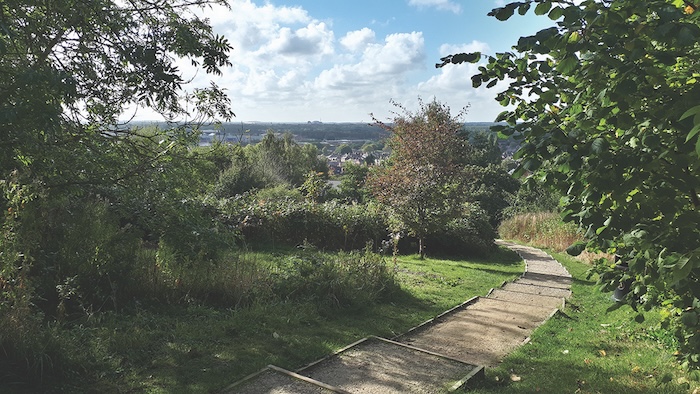
Our beautiful green spaces
Rachel Shaw
Lincolnshire Wildlife Trust
One afternoon in early autumn, I took a break from my desk and went for a short walk.
The sun was low and bright, making me wish I’d remembered my sunglasses. I slowed my pace as I passed into the shade of a roadside row of mature beech trees.
Up above me, the leaves of the trees were basking in the sunlight. Drinking in the carbon dioxide and locking in the carbon. As they had done for decades.
Looking across the landscape of Lincoln, it’s surprisingly green with trees. Each tree is taking in carbon from the atmosphere. It’s not just the trees that do this. Every plant takes in carbon and locks it away.
The science of carbon sequestration is complex and often confusing. But it’s reassuring to know that, if we let it, nature can help us get ourselves out of the climate crisis.
My stroll took me into Liquorice Park (pictured below). As I walked up the steps, I saw rose bushes bent over with the weight of hips and paused to sample a single blackberry. Just one blackberry because these hips and berries will be feasted on by blackbirds and thrushes.
The late flowering plants were busy with bees and other pollinators. Everywhere there were signs of life. Even in the leaves with holes chewed out of them; evidence of invertebrates – unseen by me – but all potential food for robins.
There’s a whole ecosystem of life in this one small space. Life that spills out into the surrounding area and moves between the parks, green spaces and gardens of the city. Liquorice Park is also a community-led green spaces cared for my local people. And it’s not the only one, there are other sites dotted around Lincoln where communities are making a difference.
Sincil Bank isn’t blessed with the green spaces and trees that other areas of Lincoln have. In this area of late nineteenth century terraced housing, many front doors open directly onto the pavement and gardens are small or non-existent. But local residents, with the support of the City of Lincoln Council, Lincoln City Foundation and others, are making a difference.
The Sincil Bank Regeneration project aims to create green spaces in Sincil Bank. They have already re-opened a tiny former children’s playground that had been locked for 15 years after the equipment had been wrecked and then removed. The volunteers thinned the cramped trees making a feature of the silver birches, created a pathway, installed seating and developed a planting scheme. Since May 2021, the new St Andrew’s Garden has been opened daily. The flora and fauna are of increasing interest.
At St John the Baptist in Ermine East, a wildflower meadow has created with the guidance of the Wildlife Trust and help of local volunteers. Seeds of over 50 wildflower and grass species have been sown in the area - many of which were gathered by hand by Wildlife Trust staff during the 2020 summer lockdown from Red Hill nature reserve in the Lincolnshire Wolds. In the summer month these flowers and attracts bees and other pollinators and providing food for birds.
These, and other places like them, may seem small and almost insignificant on their own but together they are breathing life back into our city and helping to make it more resilient. When the dust and glitter of Christmas has settled, why not consider whether you could help out at your local green space – help make it better for wildlife and people.
Top picture shows a small tortoiseshell butterfly on greater knapweed.

